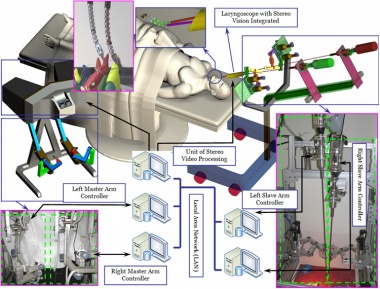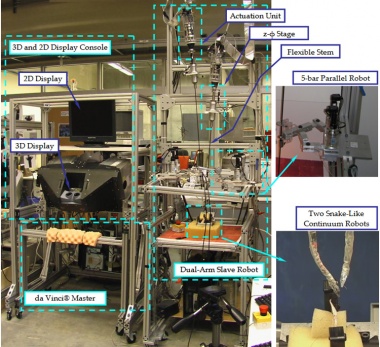From Rii
(Created page with "{{DISPLAYTITLE:<span style="display:none">{{FULLPAGENAME}}</span>}} = A Telerobotic System for Minimally Invasive Surgery of the Throat = January 2005 to August 2009 [[image:no...") |
|||
| Line 21: | Line 21: | ||
* The 5-bar parallel robot bends the flexible stem to provide precise placement of the snake-like continuum robot inside the laryngoscope. This configuration will generate much less collision problems and ensure a better overall system stiffness than if the actuation unit itself is manipulated. In the current setup, the actuation unit is rigidly fixed to a stationary base frame and the 5-bar parallel robot uses flexibility of the flexible stem in order to precisely place the snake-like robot. The placement can be approximated as a two-DoF planar motion in the kinematics modeling. | * The 5-bar parallel robot bends the flexible stem to provide precise placement of the snake-like continuum robot inside the laryngoscope. This configuration will generate much less collision problems and ensure a better overall system stiffness than if the actuation unit itself is manipulated. In the current setup, the actuation unit is rigidly fixed to a stationary base frame and the 5-bar parallel robot uses flexibility of the flexible stem in order to precisely place the snake-like robot. The placement can be approximated as a two-DoF planar motion in the kinematics modeling. | ||
* Each robotic slave arm has a total eight degrees of freedom to control the end effector (the gripper). This configuration provides kinematic redundancy for the slave arm to avoid collision with each other and/or perform complicated tasks. Since each segment of the snake-like robot has three independently actuated joints to provide actuation redundancy to optimize the load between backbones, plus one controlled joint is used to control the gripper, each robotic slave arm has eleven actuated joints. | * Each robotic slave arm has a total eight degrees of freedom to control the end effector (the gripper). This configuration provides kinematic redundancy for the slave arm to avoid collision with each other and/or perform complicated tasks. Since each segment of the snake-like robot has three independently actuated joints to provide actuation redundancy to optimize the load between backbones, plus one controlled joint is used to control the gripper, each robotic slave arm has eleven actuated joints. | ||
| + | |||
| + | In the following video clips, major components of the telerobotic system for the throat MIS are introduced, while a know tying is performed under the control of a surgeon. For sake of time, playback speed of some scenes are doubled. | ||
| + | {| | ||
| + | |align="center"|'''Overview of the Telerobotic System for Throat MIS''' | ||
| + | |align="center"|'''Knot Tying of the Telerobotic System for Throat MIS''' | ||
| + | |- | ||
| + | |<videoflash type="youku">XMjExNDQ2NTM2</videoflash> | ||
| + | |<videoflash type="youku">XMjExNDQ0MTA0</videoflash> | ||
| + | |} | ||
Revision as of 05:50, 3 October 2010
A Telerobotic System for Minimally Invasive Surgery of the Throat
January 2005 to August 2009
![]() This work was done when Dr. Kai Xu was with the Advanced Robotics & Mechanism Applications Lab, Department of Mechanical Engineering, Columbia University under a collaboration with the NSF Engineering Research Center for Computer-Integrated Surgical Systems and Technology (CISST), Johns Hopkins University.
This work was done when Dr. Kai Xu was with the Advanced Robotics & Mechanism Applications Lab, Department of Mechanical Engineering, Columbia University under a collaboration with the NSF Engineering Research Center for Computer-Integrated Surgical Systems and Technology (CISST), Johns Hopkins University.
To address the challenges of Minimally Invasive Surgery (MIS) of the throat and the upper airways, a prototype teleoperative robotic system was designed and constructed. The right figure shows the system schematic layout while the figure below shows the actual system which is running at NEF Engineering Research Center of Computer Integrated Surgical Systems and Technology (CISST), Johns Hopkins University. This system includes 2D and 3D displays, a novel highly dexterous dual-arm robotic slave, a bilateral teleoperation system, and a da Vinci® master interface from Intuitive Surgical, Inc.
The teleoperation system comprised five computers connected through a Local Area Network (LAN). Two computers are used for the dual-arm admittance-type slave robot and two computers are used for the impedance-type da Vinci® master, while a fifth computer hosts the image acquisition and display hardware. A stereo laparoscope is connected to two image capture cards to for dual video stream to generate stereo display for a surgeon and a 2D display for general purposes. Although no image processing is performed currently, incorporating visual tracking information from the video processing can be easily implemented in this system configuration in the future. Using a separate controller for each robotic arm allows modular expansion of the system, such as addition of a third slave arm, with minimal changes to the existing system.
The dual-arm slave robot consists of two robotic arms. Each robot arm is composed of i) a 2-segment snake-like continuum robot with a detachable gripper, ii) an actuation unit for the snake-like continuum robot, iii) a flexible stem which connects the snake-like robot with the actuation unit, iv) a 5-bar parallel robot which bends the flexible stem for the placement of the snake-like robot, and v) a z-φ stage which translates the snake-like robot vertically and delivers an axial rotation to the snake-like robot.
- Each 2-segment snake-like continuum robot consists of two continuum segments and a detachable gripper. The first segment is located proximal to the flexible stem while the second segment is located close to the gripper. The first segment is actuated by NiTi tubes while the second segment is actuated by NiTi thin beams passing through the first segment’s tubes. The snake-like continuum robot has four degrees of freedom to provide necessary dexterity inside the throat. Furthermore, since the robot is made from NiTi and aluminum, it could provide MRI compatibility if necessary (e.g. in neurosurgery) and support multiple modalities including drug/light/laser delivery through the tubes of the secondary backbones. The current design has Ø4.2mm disks and a pitch diameter of 3.0 mm (the diameter of the circumference around which the secondary backbones are distributed). The first segment is 23mm long and its tubular backbones have an outer diameter of 0.635mm and an inner diameter of 0.508mm. The second segment is 12mm long and its beam backbones have an outer diameter of 0.406mm. The minimal bending radius that corresponds to 4% strain in the superelastic backbones is 7.8125 mm for the first segment and 5.08 mm for the second segment. This strain limit was established based on our experimental evaluation and recent literature on fatigue of super-elastic wires, e.g. (Nemat-Nassera and Guo 2006).
- A flexible stem transmits mechanical actuation from the actuation unit to the 2-segment snake-like robot. This configuration allows remotizing the actuation units from the laryngoscope’s entry point in order to provide enough access for visualization of the larynx. Furthermore, it also allows to accommodate the size of the actuation units, since when two actuation units are placed next to each other, it requires an opening much bigger than the opening of a normally-used laryngoscope.
- Each z-φ stage provides two degrees of freedom, which are rotation about and translation along the longitudinal axis of the flexible stem. This rotation will be converted by the snake-like continuum robot into rotation about the longitudinal axis of the gripper through a special mode of operation called rotation about the backbone. When the base of the snake-like robot is rotated by the z-φ stage through the flexible stem, the snake-like robot can be controlled accordingly by assigning an angular velocity with an identical magnitude. The resultant motion will be a rotation about the longitudinal axis of the gripper, which would enable suturing motion in any direction within the orientation workspace of the snake-like robot.
- The 5-bar parallel robot bends the flexible stem to provide precise placement of the snake-like continuum robot inside the laryngoscope. This configuration will generate much less collision problems and ensure a better overall system stiffness than if the actuation unit itself is manipulated. In the current setup, the actuation unit is rigidly fixed to a stationary base frame and the 5-bar parallel robot uses flexibility of the flexible stem in order to precisely place the snake-like robot. The placement can be approximated as a two-DoF planar motion in the kinematics modeling.
- Each robotic slave arm has a total eight degrees of freedom to control the end effector (the gripper). This configuration provides kinematic redundancy for the slave arm to avoid collision with each other and/or perform complicated tasks. Since each segment of the snake-like robot has three independently actuated joints to provide actuation redundancy to optimize the load between backbones, plus one controlled joint is used to control the gripper, each robotic slave arm has eleven actuated joints.
In the following video clips, major components of the telerobotic system for the throat MIS are introduced, while a know tying is performed under the control of a surgeon. For sake of time, playback speed of some scenes are doubled.
| Overview of the Telerobotic System for Throat MIS | Knot Tying of the Telerobotic System for Throat MIS |

